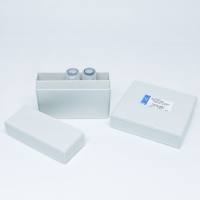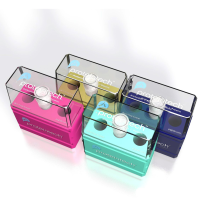Harvesting, Isolation, and Functional Assessment of Primary Vagal Ganglia Cells
互联网
- Abstract
- Table of Contents
- Materials
- Figures
- Literature Cited
Abstract
Airway sensory nerves play an important defensive role in the lungs, being central in mediating protective responses like cough and bronchoconstriction. In some cases, these responses become excessive, hypersensitive, and deleterious. Understanding the normal function of airway nerves and phenotype changes associated with disease will help in developing new therapeutics for treating chronic obstructive pulmonary disease and chronic cough. Guinea pigs, and to a lesser extent ferrets, are commonly employed for studying the cough reflex because they have a cough response similar to humans. While rats and mice do not exhibit a cough response, they do possess sensory nerves that respond to the same range of tussive stimuli as guinea pigs and humans. Described in this unit are protocols for harvesting guinea pig, mouse, and rat sensory nerve cell bodies to assess molecular and functional changes associated with pulmonary disease, and to identify new targets for therapeutic intervention. Curr. Protoc. Pharmacol . 62:12.15.1?12.15.27. © 2013 by John Wiley & Sons, Inc.
Keywords: neuron; vagal ganglia; retrograde labeling; harvesting; primary culture
Table of Contents
- Introduction
- Basic Protocol 1: In Vivo Retrograde Labeling of Airway Neurons
- Basic Protocol 2: Vagal Ganglia Harvesting from Guinea Pig
- Alternate Protocol 1: Vagal Ganglia Harvesting from Mice and Rats
- Basic Protocol 3: Enzymatic Isolation of Neurons from Vagal Ganglia
- Support Protocol 1: Functional Assessment of Primary Cultured Vagal Ganglia Neurons
- Reagents and Solutions
- Commentary
- Literature Cited
- Figures
Materials
Basic Protocol 1: In Vivo Retrograde Labeling of Airway Neurons
Materials
Basic Protocol 2: Vagal Ganglia Harvesting from Guinea Pig
Materials
Alternate Protocol 1: Vagal Ganglia Harvesting from Mice and Rats
Materials
Basic Protocol 3: Enzymatic Isolation of Neurons from Vagal Ganglia
Materials
|
Figures
-

Figure 12.15.1 Anatomical differences between the rat/mouse and guinea pig. (A ) Real‐size picture of the curved intratracheal cannula needed to dose the rats with the retrograde dye DiI. The value of the angle used to bend the cannula is given in degrees and the vertex is indicated by the cross of the dash lines located 13 mm from the tip of the cannula. (B ,C ) Diagram of the vagal ganglia in guinea pig (left panel) and mouse/rat (right panel). View Image -

Figure 12.15.2 Overview of the tools needed for the dissection and harvesting of vagal ganglia. View Image -

Figure 12.15.3 Muscle removal from head and neck section for guinea pigs. (A ‐C ) Lateral and dorsal views of the step‐by‐step removal of muscles needed to facilitate the opening of the skull and the extraction of the ear bone. View Image -

Figure 12.15.4 Skull opening and removal of the brain. (A ) Dorsal view of step‐by‐step cut and removal of the skull bones. (B ) Removal of parietal and interparietal bones. (C ) Lateral view of the brain and optical chiasma section. (D ) Dorsal view of cuts of the medulla connected nerves and the spinal cord. View Image -

Figure 12.15.5 Ear bones extraction and vagal ganglia harvesting. (A ) Cuts required in the surrounding bones to free the ear bone without dismantling the skull. (B ) 3‐D schematic showing how to handle the body while extracting the ear bone and dorsal view showing the position of the forceps during the extraction. (C ) Schematic of vagal ganglia (nodose and jugular) harvesting in guinea pig after extraction of the ear bone. Inset shows more in details how the jugular and nodose ganglia are located near the occipital bone. View Image -

Figure 12.15.6 Adjustments in muscle and bone removal for mice and rats. (A ) Lateral schematic of muscle removal from rat neck and head. (B ) Dorsal schematic of bones removal from the top of rat skull. View Image -

Figure 12.15.7 Schematic of equipment classically needed to perform epifluorescence recordings. View Image -

Figure 12.15.8 Steps to follow to load neurons with Fura2‐AM. View Image -

Figure 12.15.9 Functional assessment of an airway‐specific neuron. (A ) (1) images of neurons recorded in bright‐field differential interference contrast (DIC) microscopy mode. (2) DiI fluorescence with the light intensity expressed by a black (no light) to red (highest light) color code. (3) Combined image of DiC and DiI recordings. (4) Typical light intensity observed for Fura2 bound to calcium at rest. (5) Typical light intensity for unbound Fura2 at rest. The scale indicated on top of panel (1) is a 50‐µm scaled bar. (B ) Ratio of the light intensity emitted by calcium‐bound Fura2/unbound Fura measured by respectively exposing the neuron to λ = 340 nm and λ = 380 nm. Fluorescence scale is indicated on the left. Drug perfusions are indicated below the trace by black arrows. Time scale is given below the trace by a black bar. The pictures below the trace represent the light intensities recorded over time (examples taken as indicated with numbers on the trace). View Image
Videos
Literature Cited
| Literature Cited | |
| Ausubel, F.M., Brent, R., Kingston, R.E., Moore, D.D., Seidman, J.G., and Struhl, K. (eds.). 2013. Current Protocols in Molecular Biology. John Wiley & Sons, Hoboken, N.J. | |
| Barnes, P.J. 1996. Neuroeffector mechanisms: The interface between inflammation and neuronal responses. J. Allergy Clin. Immunol. 98:S73‐S81; discussion S81‐S73. | |
| Bautista, D.M., Jordt, S.E., Nikai, T., Tsuruda, P.R., Read, A.J., Poblete, J., Yamoah, E.N., Basbaum, A.I., and Julius, D. 2006. TRPA1 mediates the inflammatory actions of environmental irritants and proalgesic agents. Cell 124:1269‐1282. | |
| Belvisi, M.G. 2003a. Airway sensory innervation as a target for novel therapies: An outdated concept? Curr. Opin. Pharmacol. 3:239‐243. | |
| Belvisi, M.G. 2003b. Sensory nerves and airway inflammation: Role of A delta and C‐fibres. Pulm. Pharmacol. Ther. 16:1‐7. | |
| Belvisi, M.G., Dubuis, E., and Birrell, M.A. 2011. Transient receptor potential A1 channels: Insights into cough and airway inflammatory disease. Chest 140:1040‐1047. | |
| Birrell, M.A., Belvisi, M.G., Grace, M., Sadofsky, L., Faruqi, S., Hele, D.J., Maher, S.A., Freund‐Michel, V., and Morice, A.H. 2009. TRPA1 agonists evoke coughing in guinea pig and human volunteers. Am. J. Respir. Crit. Care Med. 180:1042‐1047. | |
| Canning, B.J. 2008. The cough reflex in animals: Relevance to human cough research. Lung 186:S23‐S28. | |
| Canning, B.J. 2010. Afferent nerves regulating the cough reflex: Mechanisms and mediators of cough in disease. Otolaryngol. Clin. North Am. 43:15‐25. | |
| Canning, B.J. and Spina, D. 2009. Sensory nerves and airway irritability. Handb. Exp. Pharmacol. 139‐183. | |
| De Alba, J., Raemdonck, K., Dekkak, A., Collins, M., Wong, S., Nials, A.T., Knowles, R.G., Belvisi, M.G., and Birrell, M.A. 2010. House dust mite induces direct airway inflammation in vivo: Implications for future disease therapy? Eur. Respir. J. 35:1377‐1387. | |
| Geppetti, P., Patacchini, R., Nassini, R., and Materazzi, S. 2010. Cough: The emerging role of the TRPA1 channel. Lung 188:S63‐S68. | |
| Grace, M., Birrell, M.A., Dubuis, E., Maher, S.A., and Belvisi, M.G. 2012. Transient receptor potential channels mediate the tussive response to prostaglandin E2 and bradykinin. Thorax 67:891‐900. | |
| Slatko, B.E., Kieleczawa, J., Ju, J., Gardner, A.F., Hendrickson, C.L., and Ausubel, F.M. 2011. “First generation” automated DNA sequencing technology. Curr. Protoc. Mol. Biol. 96:7.2.1‐7.2.28. | |
| Springer, J., Geppetti, P., Fischer, A., and Groneberg, D.A. 2003. Calcitonin gene‐related peptide as inflammatory mediator. Pulm. Pharmacol. Ther. 16:121‐130. | |
| Stevenson, C.S. and Belvisi, M.G. 2008. Preclinical animal models of asthma and chronic obstructive pulmonary disease. Exp. Rev. Respir. Med. 2:631‐643. | |
| Taylor‐Clark, T.E., Nassenstein, C., and Undem, B.J. 2008. Leukotriene D4 increases the excitability of capsaicin‐sensitive nasal sensory nerves to electrical and chemical stimuli. Br. J. Pharmacol 154:1359‐1368. | |
| Texier, I., Goutayer, M., Da Silva, A., Guyon, L., Djaker, N., Josserand, V., Neumann, E., Bibette, J., and Vinet, F. 2009. Cyanine‐loaded lipid nanoparticles for improved in vivo fluorescence imaging. J. Biomed. Opt. 14:054005. |








